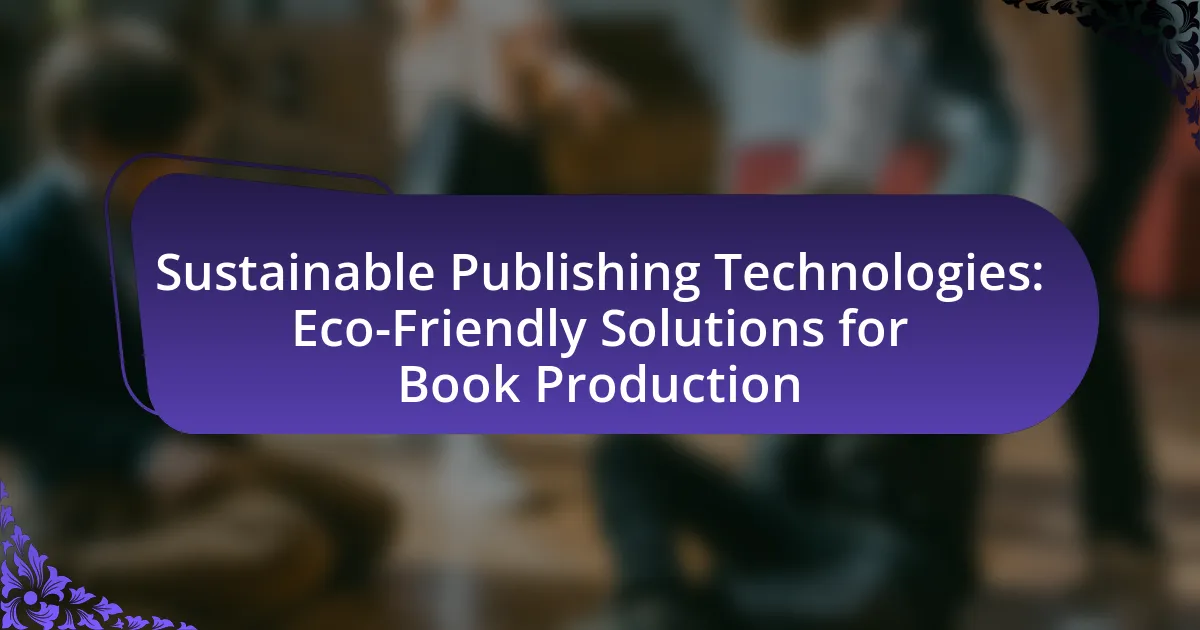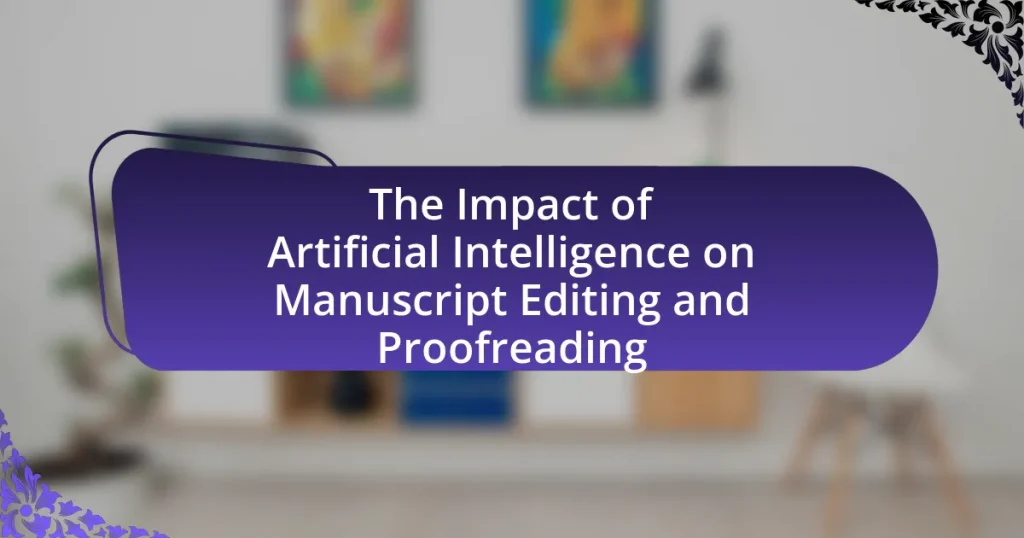Sustainable publishing technologies refer to methods and practices within the publishing industry aimed at minimizing environmental impact while ensuring efficiency and quality. These technologies encompass the use of recycled materials, eco-friendly inks, and energy-efficient printing processes, significantly contributing to eco-friendly book production. Key principles include resource efficiency, waste reduction, and the utilization of sustainable materials, which collectively reduce carbon footprints and promote a circular economy. The article explores various sustainable practices, including digital publishing solutions, biodegradable inks, and energy-efficient methods, while addressing the challenges publishers face in adopting these technologies and the economic benefits of sustainability in the publishing sector.

What are Sustainable Publishing Technologies?
Sustainable publishing technologies are methods and practices in the publishing industry that minimize environmental impact while maintaining efficiency and quality. These technologies include the use of recycled materials, eco-friendly inks, and energy-efficient printing processes. For instance, according to a study by the Book Industry Environmental Council, using recycled paper can reduce energy consumption by up to 60% compared to virgin paper production. Additionally, digital publishing platforms reduce the need for physical materials, further decreasing the carbon footprint associated with traditional publishing.
How do Sustainable Publishing Technologies contribute to eco-friendly book production?
Sustainable Publishing Technologies significantly contribute to eco-friendly book production by utilizing renewable resources, reducing waste, and minimizing carbon footprints. These technologies often incorporate recycled paper, soy-based inks, and energy-efficient printing processes, which collectively lower the environmental impact of book manufacturing. For instance, using recycled paper can save up to 60% of the energy required for producing virgin paper, while soy inks are biodegradable and less harmful than traditional petroleum-based inks. Additionally, advancements in digital printing allow for print-on-demand services, which reduce excess inventory and waste, further promoting sustainability in the publishing industry.
What are the key principles behind Sustainable Publishing Technologies?
The key principles behind Sustainable Publishing Technologies include resource efficiency, waste reduction, and the use of eco-friendly materials. Resource efficiency focuses on minimizing energy and water consumption during the publishing process, which can be achieved through digital printing and on-demand publishing methods. Waste reduction emphasizes the importance of recycling and reusing materials, such as paper and ink, to decrease the environmental impact. The use of eco-friendly materials involves selecting sustainable sources for paper and non-toxic inks, which contribute to a lower carbon footprint. These principles are supported by industry practices that aim to create a more sustainable publishing ecosystem, aligning with global efforts to reduce environmental harm.
How do these technologies reduce environmental impact?
Sustainable publishing technologies reduce environmental impact by minimizing resource consumption and waste generation during book production. For instance, digital printing techniques significantly decrease paper waste compared to traditional offset printing, as they allow for print-on-demand services that only produce copies as needed. Additionally, the use of recycled materials in book production lowers the demand for virgin resources, thereby conserving forests and reducing carbon emissions associated with raw material extraction. Furthermore, eco-friendly inks and adhesives, which are often derived from natural sources, contribute to lower levels of harmful chemicals released into the environment. These practices collectively lead to a more sustainable publishing process that aligns with environmental conservation efforts.
What types of Sustainable Publishing Technologies are available?
Sustainable publishing technologies include digital printing, print-on-demand, eco-friendly inks, and sustainable paper sourcing. Digital printing reduces waste by allowing for smaller print runs and minimizing excess inventory. Print-on-demand technology enables books to be printed only when ordered, further decreasing waste. Eco-friendly inks, such as soy-based or vegetable-based inks, are less harmful to the environment compared to traditional petroleum-based inks. Sustainable paper sourcing involves using recycled paper or paper sourced from responsibly managed forests, which helps preserve natural resources. These technologies collectively contribute to reducing the environmental impact of book production.
What are the different printing methods that promote sustainability?
Different printing methods that promote sustainability include digital printing, water-based ink printing, and soy-based ink printing. Digital printing reduces waste by allowing for print-on-demand services, which minimizes excess inventory and paper usage. Water-based inks are less harmful to the environment compared to solvent-based inks, as they contain fewer volatile organic compounds (VOCs), making them safer for both the environment and human health. Soy-based inks, derived from soybeans, are biodegradable and produce vibrant colors while reducing reliance on petroleum-based inks. These methods collectively contribute to a more sustainable printing process by lowering environmental impact and promoting the use of renewable resources.
How do digital publishing solutions enhance sustainability?
Digital publishing solutions enhance sustainability by significantly reducing the need for physical materials, such as paper and ink, which lowers environmental impact. For instance, the transition from traditional print to digital formats eliminates paper waste, as e-books and online publications do not require trees to be cut down for paper production. Additionally, digital publishing minimizes carbon emissions associated with transportation and distribution of printed materials. According to a study by the Green Press Initiative, digital publishing can reduce carbon footprints by up to 80% compared to conventional print publishing methods. This shift not only conserves natural resources but also promotes a more sustainable approach to content dissemination.
Why is it important to adopt Sustainable Publishing Technologies?
Adopting Sustainable Publishing Technologies is crucial for reducing the environmental impact of the publishing industry. These technologies minimize resource consumption, decrease waste, and lower carbon emissions associated with traditional publishing methods. For instance, using digital printing reduces paper waste by allowing for print-on-demand services, which can cut down on excess inventory and unsold books. Additionally, sustainable practices such as using recycled materials and eco-friendly inks contribute to a circular economy, promoting resource efficiency. The implementation of these technologies not only aligns with global sustainability goals but also meets the increasing consumer demand for environmentally responsible products.
What are the environmental benefits of sustainable publishing?
Sustainable publishing significantly reduces environmental impact by minimizing resource consumption and waste generation. This approach often involves using recycled materials, which decreases the need for virgin resources and lowers deforestation rates. For instance, the use of recycled paper can save up to 60% of energy and 70% of water compared to producing paper from new wood fibers. Additionally, sustainable publishing practices often incorporate eco-friendly inks and printing processes that reduce harmful emissions and pollutants. By adopting digital formats, publishers can further decrease paper usage and carbon footprints, contributing to a more sustainable ecosystem.
How does sustainable publishing affect the publishing industry economically?
Sustainable publishing positively impacts the publishing industry economically by reducing costs associated with materials and waste management. By utilizing eco-friendly materials and processes, publishers can lower their production costs; for instance, using recycled paper can decrease raw material expenses. Additionally, sustainable practices often lead to improved brand reputation, attracting environmentally conscious consumers and potentially increasing sales. A study by the Book Industry Study Group found that 70% of consumers are more likely to purchase from brands that demonstrate environmental responsibility, indicating a direct correlation between sustainability and economic benefit in the publishing sector.
How can publishers transition to Sustainable Publishing Technologies?
Publishers can transition to Sustainable Publishing Technologies by adopting eco-friendly practices such as using recycled materials, implementing digital publishing solutions, and optimizing supply chains for reduced carbon footprints. For instance, utilizing recycled paper can significantly lower deforestation rates and energy consumption, as studies indicate that recycled paper production uses 60% less energy compared to virgin paper production. Additionally, embracing digital formats reduces the need for physical materials, thereby minimizing waste and emissions associated with transportation. Furthermore, optimizing supply chains through local sourcing and efficient logistics can decrease greenhouse gas emissions, aligning with sustainability goals.
What challenges do publishers face in adopting these technologies?
Publishers face significant challenges in adopting sustainable publishing technologies, primarily due to high initial costs and the need for specialized knowledge. The transition to eco-friendly solutions often requires substantial investment in new materials and processes, which can strain budgets, especially for smaller publishers. Additionally, many publishers lack the technical expertise to implement these technologies effectively, leading to potential inefficiencies and increased operational complexity. According to a 2021 report by the Book Industry Study Group, 60% of publishers cited cost as a major barrier to adopting sustainable practices, while 45% mentioned a lack of understanding of available technologies. These factors collectively hinder the widespread adoption of sustainable publishing technologies in the industry.

What are the specific eco-friendly solutions for book production?
Eco-friendly solutions for book production include using recycled paper, soy-based inks, and sustainable binding methods. Recycled paper reduces the need for virgin materials, thereby conserving forests and reducing waste. Soy-based inks are less harmful to the environment compared to traditional petroleum-based inks, as they are biodegradable and produce less volatile organic compounds (VOCs). Additionally, sustainable binding methods, such as using water-based adhesives and minimizing plastic components, further enhance the eco-friendliness of book production. These practices collectively contribute to a reduced carbon footprint and promote sustainability in the publishing industry.
How do eco-friendly materials impact book production?
Eco-friendly materials significantly reduce the environmental impact of book production by minimizing resource consumption and waste generation. The use of recycled paper, for instance, decreases the need for virgin wood pulp, which conserves forests and reduces carbon emissions associated with logging and processing. Additionally, eco-friendly inks, such as soy-based inks, are less toxic and easier to remove during recycling processes, further enhancing sustainability. According to a study by the Green Press Initiative, using recycled paper can save up to 24,000 gallons of water per ton produced, highlighting the substantial benefits of adopting eco-friendly materials in the publishing industry.
What types of sustainable paper options are available?
Sustainable paper options include recycled paper, bamboo paper, hemp paper, and tree-free paper. Recycled paper is made from post-consumer waste, reducing the need for virgin materials and conserving resources. Bamboo paper is produced from fast-growing bamboo, which requires less water and no pesticides, making it an eco-friendly alternative. Hemp paper, derived from hemp plants, is known for its durability and requires fewer chemicals during production. Tree-free paper is made from alternative fibers such as sugarcane or agricultural waste, minimizing deforestation and promoting sustainable practices. These options collectively contribute to reducing environmental impact in the publishing industry.
How do biodegradable inks contribute to eco-friendly publishing?
Biodegradable inks contribute to eco-friendly publishing by reducing environmental impact through their ability to decompose naturally after disposal. These inks are typically made from renewable resources such as plant-based materials, which minimizes reliance on petroleum-based products. For instance, studies have shown that using biodegradable inks can significantly lower the carbon footprint associated with traditional printing processes. Additionally, biodegradable inks do not contain harmful solvents or heavy metals, which can pollute water sources and harm ecosystems. This makes them a sustainable alternative that aligns with the principles of eco-friendly publishing.
What role does energy efficiency play in sustainable book production?
Energy efficiency is crucial in sustainable book production as it significantly reduces the carbon footprint associated with manufacturing processes. By optimizing energy use, publishers can minimize greenhouse gas emissions, which are a major contributor to climate change. For instance, implementing energy-efficient technologies in printing and binding can lead to a reduction in energy consumption by up to 30%, as reported by the Environmental Protection Agency. This not only lowers operational costs but also aligns with global sustainability goals, making energy efficiency a key component in the transition towards eco-friendly publishing practices.
How can publishers implement energy-efficient practices?
Publishers can implement energy-efficient practices by adopting digital publishing technologies, utilizing renewable energy sources, and optimizing their supply chain. Digital publishing reduces the need for physical materials, thereby lowering energy consumption associated with printing and distribution. For instance, a study by the Green Press Initiative found that digital formats can save up to 90% of the energy used in traditional print production. Additionally, using renewable energy sources, such as solar or wind power, can significantly decrease the carbon footprint of publishing operations. Furthermore, optimizing the supply chain by selecting local suppliers and minimizing transportation distances can lead to reduced energy usage. These strategies collectively contribute to a more sustainable publishing model.
What are the benefits of using renewable energy sources in publishing?
Using renewable energy sources in publishing significantly reduces carbon emissions, contributing to a more sustainable industry. By utilizing solar, wind, or hydroelectric power, publishing companies can decrease their reliance on fossil fuels, which are major contributors to greenhouse gas emissions. For instance, a study by the National Renewable Energy Laboratory found that transitioning to renewable energy can cut emissions by up to 80% in certain sectors. Additionally, renewable energy often leads to lower operational costs over time, as energy prices from renewable sources tend to be more stable compared to traditional energy markets. This financial benefit, combined with the positive environmental impact, makes renewable energy a compelling choice for the publishing industry.
How can technology innovations enhance sustainability in publishing?
Technology innovations can enhance sustainability in publishing by enabling digital formats, reducing paper waste, and optimizing supply chains. Digital publishing eliminates the need for physical materials, significantly decreasing the carbon footprint associated with traditional printing processes. For instance, e-books and online journals have gained popularity, leading to a reduction in paper consumption; a study by the Book Industry Study Group found that e-books accounted for 20% of the U.S. book market in 2020, illustrating a shift towards more sustainable practices. Additionally, advancements in print-on-demand technology minimize excess inventory and waste, as books are only printed when ordered, further supporting sustainable publishing efforts.
What are the latest advancements in sustainable printing technology?
The latest advancements in sustainable printing technology include the development of water-based inks, biodegradable substrates, and energy-efficient printing processes. Water-based inks reduce harmful emissions and are less toxic compared to traditional solvent-based inks, making them safer for both the environment and human health. Biodegradable substrates, such as those made from recycled materials or plant-based fibers, minimize waste and enhance the recyclability of printed products. Additionally, energy-efficient printing processes, including digital printing technologies that consume less power and produce less waste, contribute to a lower carbon footprint in the printing industry. These advancements collectively support the goal of reducing environmental impact while maintaining high-quality printing standards.
How can automation and AI contribute to eco-friendly practices?
Automation and AI can significantly contribute to eco-friendly practices by optimizing resource usage and reducing waste in various processes. For instance, AI algorithms can analyze data to streamline supply chains, minimizing excess inventory and transportation emissions. Additionally, automation in printing processes can lead to more precise material usage, reducing paper waste. According to a study by the Ellen MacArthur Foundation, implementing AI in manufacturing can lead to a 20-30% reduction in resource consumption, which directly supports sustainable practices. Furthermore, AI-driven predictive maintenance can enhance the longevity of equipment, decreasing the need for replacements and conserving materials.

What best practices should publishers follow for sustainable book production?
Publishers should prioritize the use of recycled materials and eco-friendly inks to ensure sustainable book production. Utilizing recycled paper reduces the demand for virgin materials, thereby conserving forests and minimizing waste. Eco-friendly inks, often made from vegetable oils, are less harmful to the environment compared to traditional petroleum-based inks, which can release volatile organic compounds during production. Additionally, implementing print-on-demand technology can significantly decrease overproduction and waste, as books are only printed when ordered. According to a study by the Book Industry Environmental Council, adopting these practices can lead to a substantial reduction in the carbon footprint associated with book production.
How can publishers measure their sustainability efforts?
Publishers can measure their sustainability efforts by utilizing key performance indicators (KPIs) such as carbon footprint analysis, paper sourcing practices, and waste management metrics. Carbon footprint analysis quantifies greenhouse gas emissions associated with production processes, allowing publishers to identify areas for improvement. Tracking paper sourcing practices ensures that materials are sourced from sustainable forests, which can be verified through certifications like FSC (Forest Stewardship Council). Additionally, waste management metrics assess the efficiency of recycling and waste reduction initiatives, providing insight into overall sustainability performance. These methods enable publishers to create a comprehensive overview of their environmental impact and progress towards sustainability goals.
What metrics are used to evaluate sustainability in publishing?
Metrics used to evaluate sustainability in publishing include carbon footprint, paper sourcing, energy consumption, waste management, and water usage. Carbon footprint measures the total greenhouse gas emissions associated with the production and distribution of published materials. Paper sourcing assesses the use of recycled or sustainably sourced paper, which impacts deforestation and biodiversity. Energy consumption evaluates the amount of energy used in the printing and distribution processes, while waste management looks at how much waste is generated and how it is disposed of or recycled. Water usage quantifies the water consumed during production, highlighting the resource’s sustainability. These metrics provide a comprehensive framework for assessing the environmental impact of publishing practices.
How can publishers track their environmental impact effectively?
Publishers can track their environmental impact effectively by implementing comprehensive sustainability metrics and utilizing carbon footprint calculators. These tools allow publishers to measure key factors such as paper usage, energy consumption, and waste generation throughout the production process. For instance, the Carbon Trust provides a carbon footprint calculator specifically designed for the publishing industry, enabling publishers to quantify their emissions and identify areas for improvement. Additionally, adopting life cycle assessment (LCA) methodologies can help publishers evaluate the environmental impact of their products from raw material extraction to end-of-life disposal, providing a holistic view of their sustainability efforts.
What are some practical tips for implementing sustainable practices?
To implement sustainable practices in publishing, prioritize using recycled materials for paper and packaging, as this reduces waste and conserves resources. Research indicates that using recycled paper can save up to 60% of energy and 70% of water compared to producing new paper. Additionally, adopt digital publishing methods to minimize physical production, which can significantly lower carbon footprints. Implementing energy-efficient printing technologies, such as using vegetable-based inks and energy-saving printers, further enhances sustainability. Lastly, establish a supply chain that emphasizes local sourcing to reduce transportation emissions, thereby supporting local economies and decreasing environmental impact.
How can publishers engage with eco-conscious consumers?
Publishers can engage with eco-conscious consumers by adopting sustainable practices in their production processes. This includes using recycled materials for printing, implementing eco-friendly inks, and minimizing waste through digital publishing options. Research indicates that 66% of consumers are willing to pay more for sustainable brands, highlighting the market potential for publishers who prioritize environmental responsibility. By transparently communicating these practices and their environmental impact, publishers can build trust and loyalty among eco-conscious readers.
What partnerships can enhance sustainability efforts in publishing?
Collaborations with eco-friendly paper suppliers and sustainable printing companies can significantly enhance sustainability efforts in publishing. These partnerships enable publishers to source recycled or sustainably sourced materials, reducing the environmental impact of book production. For instance, companies like Mohawk Fine Papers and FSC-certified suppliers provide options that minimize deforestation and promote responsible forestry practices. Additionally, alliances with technology firms specializing in digital publishing can reduce the need for physical materials, further decreasing waste. Research indicates that adopting sustainable practices in publishing can lead to a 30% reduction in carbon emissions, demonstrating the effectiveness of these partnerships in promoting eco-friendly solutions.
What common pitfalls should publishers avoid in sustainable publishing?
Publishers should avoid the pitfall of prioritizing cost over sustainability in their production processes. This often leads to the use of cheaper, non-eco-friendly materials that harm the environment. For instance, opting for conventional paper instead of recycled or sustainably sourced paper can significantly increase the carbon footprint of a publication. Additionally, neglecting to assess the entire supply chain for sustainability can result in hidden environmental impacts, such as excessive transportation emissions. Publishers must also avoid greenwashing, which is the practice of misleading consumers about the environmental benefits of a product. This can damage credibility and trust with readers who are increasingly concerned about sustainability. Lastly, failing to engage with stakeholders, including authors and consumers, about sustainable practices can lead to missed opportunities for collaboration and innovation in eco-friendly publishing solutions.
How can publishers ensure compliance with sustainability standards?
Publishers can ensure compliance with sustainability standards by implementing eco-friendly practices throughout their production processes. This includes sourcing materials from certified sustainable suppliers, utilizing recycled paper, and adopting energy-efficient printing technologies. For instance, the Forest Stewardship Council (FSC) certification guarantees that paper products come from responsibly managed forests, which supports environmental sustainability. Additionally, publishers can conduct regular audits of their supply chains to verify adherence to sustainability criteria, thereby reinforcing their commitment to eco-friendly practices.
What are the risks of greenwashing in the publishing industry?
The risks of greenwashing in the publishing industry include loss of consumer trust, potential legal repercussions, and damage to brand reputation. When publishers falsely claim eco-friendly practices, they mislead consumers who prioritize sustainability, leading to disillusionment and a decline in sales. For instance, a 2021 study by the European Commission found that 77% of consumers are concerned about greenwashing, indicating a significant risk for companies that engage in deceptive marketing. Additionally, regulatory bodies may impose fines or sanctions on publishers that violate advertising standards related to environmental claims, further exacerbating financial risks. Ultimately, greenwashing undermines genuine efforts toward sustainability and can result in long-term harm to both the industry and the environment.



